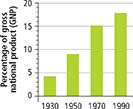American Issues  Connector: Government’s Role in the Economy
Connector: Government’s Role in the Economy

Activists protest plans to privatize Social Security.
TRACK THE ISSUE
![]() What is the proper balance between free enterprise and government regulation of the economy?
What is the proper balance between free enterprise and government regulation of the economy?
In theory, a free-enterprise system should function with little government interference. In practice, though, our government often plays a strong economic role. How much government regulation of the economy is appropriate? Use the timeline below to explore this enduring issue.
-
1906 Pure Food and Drug Act
Progressive law regulates the safety of food and medicine.
-
1913 Federal Reserve Act
Federal Reserve system is established to control the money supply.
-
1933 Agricultural Adjustment Act
New Deal law pays farmers to reduce production, causing higher crop prices and farm profits.
-
2001 Tax Cuts
Government lowers taxes in an effort to promote economic growth.
1890 Sherman Antitrust Act
Congress tries to curb the power of monopolies.
DEBATE THE ISSUE
Social Security’s Effectiveness The government manages retirement accounts for millions of Americans through the Social Security system. But with the coming retirement of millions of baby boomers, some people believe that Social Security can no longer achieve its original goals.
“Well, the system is facing serious financial problems, but more than that it has become an increasingly bad deal for today’s workers. Workers are paying 12 1/2 percent of their income into a system that is providing a poorer and poorer return. It’s a system in which workers don’t own their assets, have no legal rights to their benefits, don’t control their money, and a system that penalizes groups like African Americans and working women.”
—Michael Tanner, Cato Institute
“Social Security is one of the most successful government programs. It has consistently provided a safety net for seniors so that retirees are able to support themselves through their retirement and pay for food, housing, and medical costs. By helping to support the elderly and vulnerable among us, Social Security provides Americans with the guarantee of security for life.”
—Center for American Progress
Federal Social Welfare Spending
 TRANSFER Activities
TRANSFER Activities
- Compare Do you think that today’s Center for American Progress would support or oppose New Deal laws like the AAA?
- Analyze Costs and Benefits Compare the data on this page to the data in the Section 2 Social Security feature. Do you think that the costs of Social Security outweigh the benefits?
- Transfer Use the following Web site to see a video, try a WebQuest, and write in your journal. Web Code: neh-8202





